Scenic surroundings,
a Gentleman’s yacht, and
a compact
Square-rigger
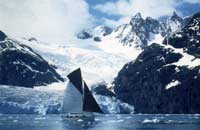
(click images to enlarge) |

|
Surroundings often enhance the pleasure of sailing
fullsize boats and model yachts. Take the absolutely
magnificent area in the first photograph above in
which the celebrated Falmouth punt, Curlew is seen in the South Atlantic, that wonderful photograph
made available to me by the owners of Curlew at the time, Tim and Pauline Carr. In 1998 Curlew was generously donated to the National Maritime
Museum in Falmouth, Cornwall in England. In the
second photograph above I move into the world of model
yacht racing, three one metre boats seen in the foreground
of New Zealand’s majestic, Mount Taranaki.
What nicer surroundings could anyone ask for?
Quite 'splendiferous' is Aucklander, Malcolm Wilkinson’s
circa 1770 gentleman’s yacht Bonny photographed by Richard Gross, the photos (below)
taken on Onepoto lagoon on Auckland’s North
Shore in the North Island of New Zealand The model
was built to a Swedish design by Frederic Chapman
whom I believe is the same naval architect that designed
the famous Swedish ship Wasa. The model is
`pretty as’, with tidy classic lines of the
period, the gentleman owners cabin intricately detailed
inside with murals on either side created in the style
that Wilkinson, originally a cabinet maker is known
for.
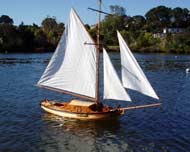 |
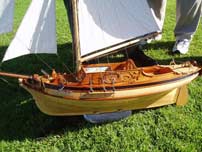
|
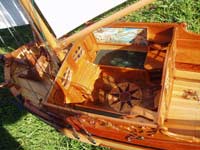 |
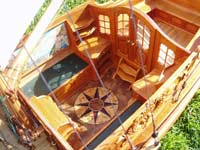
|
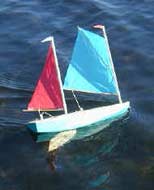 |

|
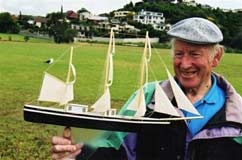 |
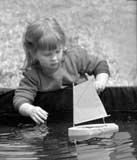
|
As ageing windlers slip anchor and `sail away, should
we be looking ourselves, towards the development of
a suitable simple little model sailing boat that would
form the basis for the initial introduction to model
sailboating of future generations of kids ? The current
crop, fed on technology off the internet, and pursuing
cellphones and texting and other modern pleasures,
have little time and interest in the magic of model
yacht building and sailing, for young minds it is
just too slow and boring. A few years ahead however,
the present still growing interest in non-pressure
sailing or windling as practiced by us oldies could
well spawn in the minds of the young.
George and Marla Surgent of Seaworthy Small Ships in Maryland are of course meeting some demand by youngsters,
and David Beede is still producing his Simplicity models I have noted. Roy Lake of Auckland has built
four or five little square-rigged, rudderless `whoosh
downwind(ers)’ and generously given four of
them to a handful of school kids who on occasion sail
them merrily down the stream of an estuary on the
north shore of New Zealand’s North Island, the
fifth, Gundaroo (which he is seen holding)
he gave to the writer.
Bill Richards of MA, USA may well have a point in
his view that there is a further need and has shared
with me a photo he took of a simple spritsail model
that comes pretty close to what he envisages. This
(Bill envisages) could be built by members of clubs,
each producing specific sections or parts on Winter
evenings. Does the need exist and is the practicality
of such a production system possible, and would it
prove successful in the present `what’s in it
for me’ world that we live in - what do you
think I wonder?
When being complimented on your new model it is worth
remembering that a pat on the back is only a few centimeters
from a kick in the butt!
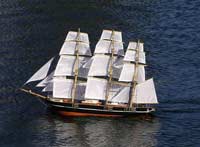 |

|
|
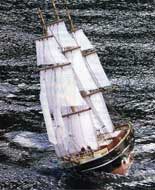
|
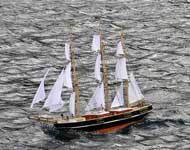
|
|
Ann Louise is a lovely square-rigger. I
have commented before and I will say it again –
go back ten or twelve years and a sailing square-rigged
model sailing ship was quite rare, and with the passage
of time and mounting interest in such vessels, today
there are many more coming out of the work sheds of
modellers. Meet Neville Wade (above) who after a lifelong
interest in the last of the sailing ships, those sailing
up to World War II, three and a bit years ago started
ship modelling as a hobby. The chosen subject was
a Danish training ship of the 1880’s called
the Georg Stage, later sailed around the
world in the years 1934-1936 as the Joseph Conrad.
Now retired at fifty-eight, Nev is a member of a very
small but long established club called the Sheffield
Ship Model Society. He sails regularly with other
members who are in their seventies and eighties who
are a mine of help and experience, sailing on a very
small pond in Millhouses Park, particularly in the
Winter months. Harold Underhill plans were used and
the model built at 1:40th scale so that it would fit
into the family car. Named after their daughter, the
boat hull was made of a mixture of plywood sheet and
limewood strip, sealed on the inside using fiberglass
sheet and resin. The sails were cut from kite material.
The boat sails well, it’s purpose being to give
pleasure to Nev and to anyone who comes to watch it,
and by doing so, hopefully to remind everyone what
a beautiful thing a sailing square rigger was. Length
overall is 860mm from the forward end of the fo’c’sle
to the stern rail, 1130mm from the bowsprit end to
the stern rail, and she is indeed a very compact boat
capable of being easily stowed for trips to the pond
in the rear of the owners car.
 |

|
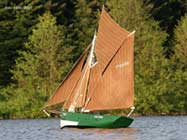 |
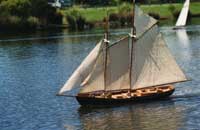
|
A much admired RC model by Andrew Charters of Meggett,
South Carolina, USA of the Nathaniel Herreshoff designed
70’ Gloriana (above left) then Hans
Staal of the Netherlands’ photograph of the
1.5m long Langoustier, Red Atao built by
Wim Stackelenburg of the Netherlands, and to the right
of that, an Auckland, New Zealand model by Brian Cuthbert,
one of several of much admired, good performing fishing
schooners that he is known for.
|

|
|
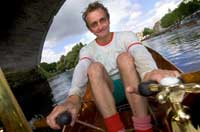
|
Some viewers may not have heard of Tim FitzHigham who may not even have an interest in model sailing
boats nor be a sailor of conventional water craft.
Although we are in touch, I don’t know that
for certain either, but a UK friend who had been to
a couple of Tim’s stage shows is adamant that
this man is `wickedly funny’ and has sailed
a boat made of paper up the Thames and crossed from
France to England in a copper bath mounted on two
hulls which he rowed. If that were not enough, Tim
also lived as a recluse in a cave on a Spanish desert,
in a personal quest to be a medieval Knight and is
considered by others to act and attempt some very
stupid plans. A comic actor who delights in making
people laugh, he claims to be part of the `Unholy
alliance against normality’.
I believe that our world needs exciting wacky people
to undertake the seemingly impossible and often absurd
and make people laugh. We live in a world of worry
and tension and mounting dangers, a world in which
people chase personal fortunes, some even prepared
to trample over anyone in a greedy rampage in order
to attain their objectives.The world needs to slow
down and we need to relax, loosen up and hold on to
an ability to laugh like we used to as children, live
a bit outrageously so long as it doesn’t do
more than make others smile. We could all take a lesson
from the late Spike Milligan who said “Blessed
are the cracked for they let in the light”.
Yes, and also from Tim FitzHigham, described
as `an inveterate shenanaganist!’
|
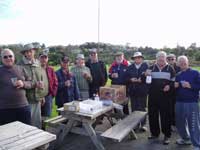
|
Blessed are the cracked indeed ! One of the many
nice touches in the life of that oft-mentioned Auckland
windling group of ours are the periodic `shouts’
whereby food and drink are served pondside. Since
we are all in the `seventy plus’ age bracket,
how about wine with the label Pino More (if
you get my drift?) when new boats are launched, sometimes
on birthdays, major Anniversaries etc. It goes well
with the sandwiches, sausage rolls and cake. “Boats
out of the water guys – The Shout is on !”
We refuse to change our policy of having fun and acting
a bit outrageously. (A bit did I say ?)

A well thought out `el cheapo’
accessory to cover your transmitter if sailing in
the rain ? It is called a `plastic bag’,
preferably one with no writing on it, after all
you don’t want to reveal to the world where
you buy your bread, now do you?
|

